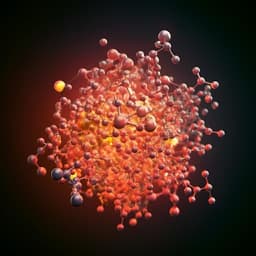
Health and Fitness
Detrimental effects of branched-chain amino acids in glucose tolerance can be attributed to valine induced glucotoxicity in skeletal muscle
C. A. Bishop, T. Machate, et al.
This groundbreaking study by Christopher A. Bishop and colleagues reveals that while leucine can enhance metabolic health by improving adiposity and insulin sensitivity, valine may have detrimental effects, worsening glucose tolerance and insulin signaling. Discover how branched-chain amino acids could impact your health!
~3 min • Beginner • English
Introduction
The study addresses the protein paradox in metabolic health: while high protein intake shows anabolic and weight-loss benefits in interventions, epidemiological data often associate lower protein intake with improved health. BCAAs (leucine, valine, isoleucine) are essential amino acids implicated in metabolic regulation, yet evidence is contradictory. Elevated circulating BCAA (“BCAA signature”) is a hallmark of obesity and type 2 diabetes and is linked to impaired BCAA catabolism and insulin resistance. While leucine and isoleucine supplementation can mitigate HF diet effects, BCAA mixture supplementation has been reported to impair insulin sensitivity. The specific long-term role of valine in an HF context remains unclear. The authors hypothesize that valine may have distinct, potentially detrimental effects on glucose homeostasis under HF feeding, possibly via 3-hydroxyisobutyrate (3-HIB), a valine-derived metabolite associated with glucose intolerance.
Literature Review
Prior work shows elevated circulating BCAAs in obesity and type 2 diabetes and impaired BCAA catabolism contributing to insulin resistance. Mouse studies indicate BCAA mixture supplementation can induce obesity and shorten lifespan, and in an HF context may worsen insulin sensitivity while affecting adiposity via lipolysis. Restricting dietary BCAAs or pharmacologically enhancing BCAA catabolism improves metabolic health. High protein diets can promote weight loss and improve metabolic outcomes, and leucine or isoleucine supplementation can protect against HF-induced weight gain and improve glucose tolerance. Recent data implicate the valine-derived metabolite 3-HIB in promoting endothelial fatty acid uptake and glucose intolerance and associate it with hyperglycemia/type 2 diabetes. However, the long-term metabolic effects of valine supplementation specifically under HF feeding are not well characterized.
Methodology
In vivo: Male C57BL/6JRj mice (12 weeks old) were group-housed on a 12-h light/dark cycle and randomized to diets for 4 or 20 weeks with ad libitum access. Diets included low-fat (LF), high-fat (HF; 40% energy from fat), and HF diets supplemented with either milk protein (HFMP), leucine (HFL), or valine (HFV). Key diet components (g/kg): HFMP had casein 280 vs 140 in HF; HFL and HFV contained 50 g/kg L-leucine or L-valine, respectively. Other components (e.g., starches, sugars, lipids) were matched; energy density ~20.1 kJ/g for HF variants. Animals were fasted (2 h) prior to necropsy for plasma and tissue collection. A subset received intraperitoneal insulin (0.75 U/kg) after 4 weeks for acute signaling assays. Ethics approval was obtained (Brandenburg, Germany; approval no. 2347-17-2018). Phenotyping: Body weight and composition were measured weekly; fat mass by NMR. Indirect calorimetry (week 12) assessed food intake, energy expenditure (EE), locomotor activity, and respiratory exchange ratio (RER). Energy intake was calculated from measured food intake and bomb calorimetry-derived energy content. Glucose homeostasis: Oral glucose tolerance tests (oGTT; 2 g/kg glucose by gavage) were performed at weeks 6 and 16 after a 16-h fast, with concurrent plasma insulin measurements. Intraperitoneal insulin tolerance tests (ITT; 0.75 U/kg) were performed after a 2-h fast at week 16. Biochemistry and molecular assays: Liver and quadriceps triacylglycerol (TAG) and quadriceps diacylglycerides (DAG) were quantified with commercial kits. Liver glycogen was measured enzymatically. Histological liver lipid content was quantified from H&E-stained sections via ImageJ. Plasma BCAA were quantified by LC-MS/MS with isotopically labeled internal standards. Plasma 3-HIB and ketone bodies were quantified by GC-MS/MS. Plasma lactate was measured on a clinical analyzer. Gene expression was determined by qRT-PCR (ddCT; reference genes B2m or Hprt). Protein expression and phosphorylation were analyzed by Western blot; BCKDHA phosphorylation and hexokinase I/II; PKCθ membrane fractionation was performed to assess translocation. In vitro: C2C12 myotubes were differentiated (DMEM, 3% horse serum) for 7 days, then treated under lipid-loaded conditions (BSA-complexed palmitate, 250 µM) with 2 mM L-valine or 2 mM sodium 3-hydroxyisobutyrate (3-HIB) for 24–48 h. Insulin stimulation (100 nM) was applied for 15–30 min as indicated. Basal and insulin-stimulated glucose uptake was measured using the Glucose Uptake-Glo assay. GLUT1 was inhibited with BAY-876 (25 nM) in selected experiments. Statistics: Data are mean ± SEM or box-and-whisker as indicated. Normality was assessed; parametric comparisons by one-way ANOVA with Bonferroni post hoc, nonparametric by Kruskal–Wallis. Grubbs outlier tests were used. Pearson correlation coefficients (R²) were reported. Significance threshold p < 0.05.
Key Findings
- Body weight and adiposity: HFMP (high milk protein) and HFL (leucine) reduced body weight gain and fat mass vs HF; HFV (valine) did not prevent HF-induced weight gain and increased fat mass, notably subcutaneous WAT. - Energy balance: No significant differences in food or energy intake, locomotor activity, or RER among HF groups. HFL increased energy expenditure during both day and night. - Glucose homeostasis: HFV impaired glucose tolerance at 6 and 16 weeks, with increased glucose iAUC in oGTT; insulin secretion during oGTT was similar to HF, indicating peripheral insulin resistance. HFL showed insulin levels similar to LF and improved ITT response; HFMP showed no consistent improvement vs HF. - BCAA exposure: Calculated intake increased ~6-fold for leucine in HFL and ~4-fold for valine in HFV vs HF. HFV elevated fasting plasma valine ~4-fold (observed at 4 and 20 weeks) without affecting leucine or isoleucine; HFMP modestly increased leucine and isoleucine by 20 weeks. - Correlations: Plasma valine (20 weeks) correlated with final fat mass (R²=0.371, p<0.02), sWAT mass (R²=0.417, p<0.008), and glucose iAUC (R²=0.535, p<0.05). - 3-HIB: HFV increased circulating 3-hydroxyisobutyrate (3-HIB), a valine-derived metabolite. - BCAA catabolism: In liver, HFL and HFMP reduced inhibitory BCKDHA phosphorylation; HF and HFV exhibited higher inhibitory phosphorylation, consistent with hepatic lipid accumulation. HFL increased hepatic Bcat2 and Ppm1k expression. In muscle, HFV increased expression of BCAA transport and catabolic genes (Slc3a2, Bcat2, Bckdhb, Ppm1k, Hadha) without increased inhibitory BCKDHA phosphorylation, suggesting shunting of BCAA catabolism toward muscle. - Muscle metabolism and signaling (in vivo): At 20 weeks, HFV mice had highest muscle glycogen and elevated plasma lactate; Glut1 mRNA was increased (Glut4 downregulated across HF groups), HKII protein was decreased, and DAG content was highest (TAG unchanged). PKCθ membrane translocation and IRS1, JNK, mTOR signaling were not different. Trib3 mRNA was upregulated. After 4 weeks, HFV showed reduced muscle glycogen formation and decreased AKT phosphorylation following acute insulin, indicating impaired insulin signaling. - In vitro mechanistic tests: In C2C12 myotubes under palmitate load, 2 mM valine or 2 mM 3-HIB for 24–48 h increased Glut1 and Trib3 expression, reduced insulin-stimulated AKT phosphorylation, and increased basal glucose uptake (both valine and 3-HIB). Only 3-HIB reduced insulin-stimulated glucose uptake. The GLUT1 inhibitor BAY-876 reversed Trib3 induction and rescued insulin-stimulated AKT phosphorylation in 3-HIB-treated cells. - Overall mechanism: Valine raises plasma 3-HIB, elevates basal GLUT1-mediated muscle glucose uptake, causing intracellular hyperglycemia (glucotoxicity), DAG accumulation, TRIB3 induction, and downstream inhibition of AKT, leading to insulin resistance.
Discussion
This study disentangles the divergent roles of individual BCAAs under high-fat feeding. Leucine and high milk protein protected against HF-induced adiposity, with leucine also improving insulin sensitivity, likely via increased energy expenditure and reduced hepatic lipid accumulation. In stark contrast, valine supplementation exacerbated glucose intolerance and insulin resistance without affecting energy intake or expenditure. Mechanistically, valine increased circulating valine and its metabolite 3-HIB, shifted BCAA catabolism toward skeletal muscle, and induced muscle-specific changes consistent with glucotoxicity: increased GLUT1 expression and basal glucose uptake, elevated glycogen and lactate, HKII downregulation, and DAG accumulation. Despite DAG increases, canonical upstream insulin resistance pathways (PKCθ translocation, IRS1, JNK, mTOR) were not activated; instead, reduced insulin-stimulated AKT phosphorylation and increased Trib3 suggest a downstream inhibitory mechanism. In vitro, valine and 3-HIB recapitulated increased basal glucose uptake and reduced insulin signaling; inhibition of GLUT1 abrogated TRIB3 induction and rescued AKT phosphorylation, supporting a model in which 3-HIB-driven, GLUT1-mediated basal glucose influx induces glucotoxic stress (including TRIB3 upregulation) that impairs insulin signaling. These findings clarify that the adverse metabolic effects attributed to BCAA mixtures may be driven predominantly by valine, while leucine can confer protective effects, underscoring the importance of protein quality in dietary interventions and revealing 3-HIB/GLUT1/TRIB3 signaling as potential therapeutic targets.
Conclusion
Long-term leucine supplementation under high-fat feeding protects against adiposity and improves insulin sensitivity, similar to high milk protein intake. In contrast, valine supplementation worsens glucose tolerance and insulin sensitivity, linked to elevated circulating valine and 3-HIB. The data support a mechanism wherein 3-HIB increases basal, GLUT1-mediated glucose uptake in skeletal muscle, leading to glucotoxicity and TRIB3-mediated inhibition of AKT signaling. These results highlight substantial differences among individual BCAAs and suggest that high valine intake in the context of a high-fat diet contributes to metabolic dysfunction. Future work should evaluate the translational relevance in humans, delineate tissue-specific contributions, and assess whether targeting 3-HIB production/signaling or GLUT1-mediated flux mitigates valine-driven insulin resistance.
Limitations
Related Publications
Explore these studies to deepen your understanding of the subject.







